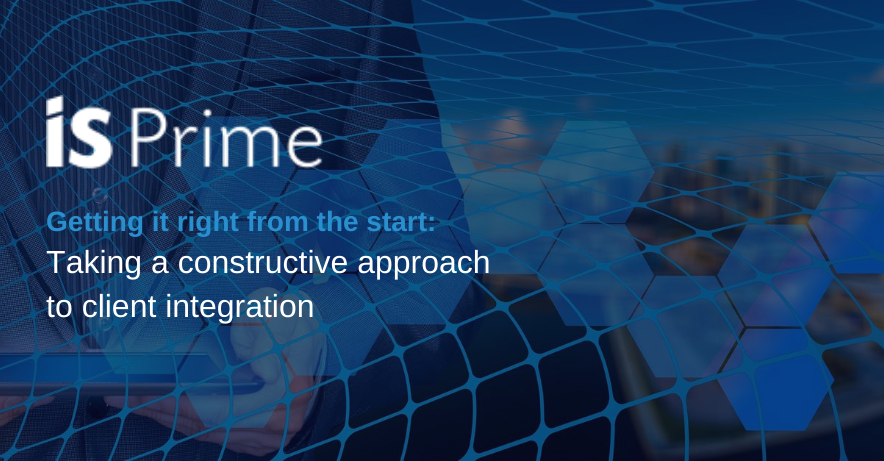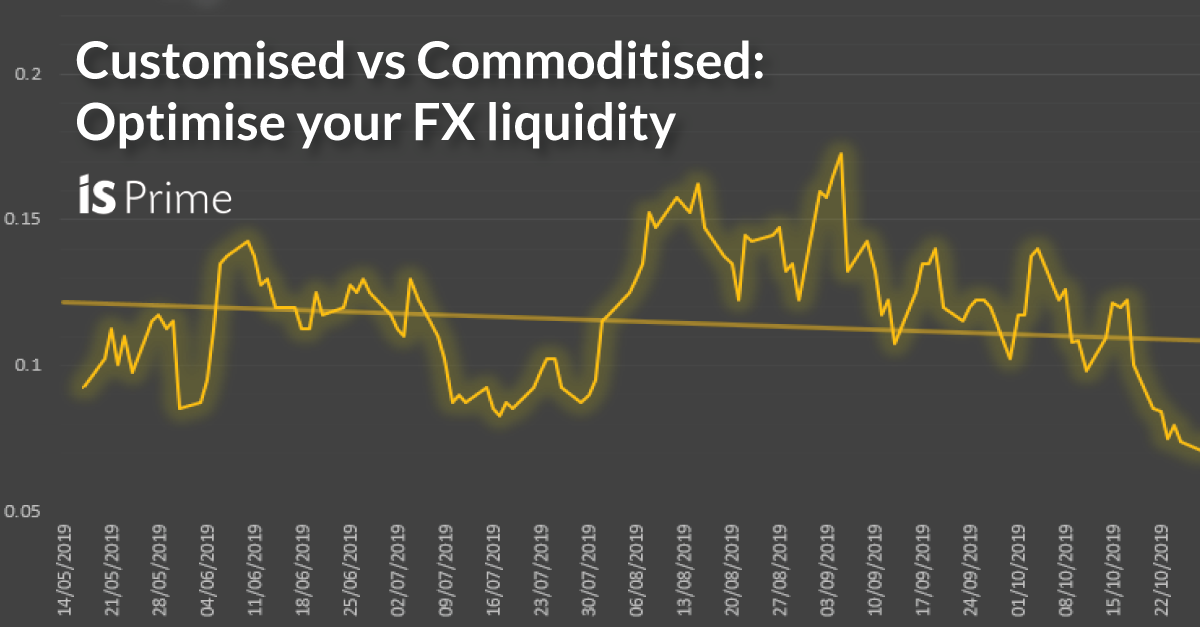Getting it right from the start: Taking a constructive approach to client integration

Whenever a firm decides to work with a new Prime of Prime (PoP), there are a number of steps involved and various factors to consider. Firms – particularly retail brokers servicing their own end clients - may not realise that the way the PoP approaches their initial onboarding process, their technology integration and their continued, ongoing support, will all become key factors in the success or failure of their business and their ability to service their own end clients.
.png?width=884&name=A%20look%20at%20IS%20Prime%E2%80%99s%20Operations_%20Taking%20a%20constructive%20approach%20to%20client%20integration%20(1).png)
The purpose of this article is therefore to highlight the best practices that firms should expect when going through an onboarding process with a PoP, and to outline the constructive approach that IS Prime takes to client integration in order to ensure that they not only receive a seamless onboarding experience but that they also get the most out of the relationship over the long term.
Understanding the client’s current environment
The first important consideration is around the client’s current connectivity & third-party technology setup. A PoP should always look to add value to a client’s existing setup rather than force them to change their business model, their operations or their workflow, just to accommodate the PoP or similarly on the inverse, the underlying technology vendor.
At IS Prime, one of the first things that we do before any technical integration is to spend time in our initial discussions understanding the client’s existing environment. Which data centres are they in, how do they connect, how do their clients connect, which third-party pieces of technology or bridges do they use and what kind of proprietary systems might we need to interface with.
This is a much more refined and collaborative procedure than a ‘plug it in & hope for the best’ approach, so at this initial stage it’s essential to get down to the nuts and bolts and go through everything in granular detail.
Why that's important becomes clear during the second phase of the client/PoP relationship, when the client actually start trading. If the PoP understands the client’s setup and topology from the outset, potential issues are avoided such as quote delays and unexplained latency that could result in slippage, client complaints and an overall poor trading experience.
Optimising the client’s setup for pricing and execution
Much of the value a PoP should offer is in helping clients set up their environment to ultimately get the best out of the existing technology that they have, in a non-intrusive and non-disruptive way. Clients will have their own technology stacks, so the PoP should be in a position to understand all of these different platforms and be able to help fine tune and optimise them.
We’ve written about this optimisation process previously in a couple of blogs ("customised-vs-commoditised: optimise your fx liquidity" & "workflow optimisation: essential-for-fx-brokers"), but it is worth re-stating that some of these set-ups can be exceedingly complex. This means that clients wouldn't necessarily get the dedicated help that they need from the technology providers. Not because the tech vendors are being obstructive, but more because they don't specialise in execution and flow dynamics.
For example, whereas the technology vendors wouldn't necessarily understand the nuances of why something needs to be set up in a certain way to produce the optimal execution solution for the client’s business, at IS Prime we can help our clients configure their technology to send orders through to us in a particular way based on the type of end-client flow, so that those orders can be executed cleanly and effectively in to the market.
In addition to understanding the technology platforms, the PoP should have a deep understanding of their clients' businesses, so that they can price them exactly as they need to be priced, across whatever currency pairs or products they are trading. At IS Prime, our in-house proprietary technology can assist with minimising the market impact and adverse execution around situations such as copy flow, which we covered in our blog post “Why copy trading needs to be carefully managed.” We can also help our clients identify toxic flow, or institutional traders masquerading as retail clients, and ensure that the correct pricing and liquidity is matched appropriately to the type of flow.
Clients might not initially understand why we ask the questions that we ask, but they do all eventually understand the value of those questions, because when we progress through the onboarding stage, the benefits are seen immediately. Not only have we already foreseen potential issues, but we've actually prevented problems from occurring without the clients having to take corrective action themselves.
Pricing
An increasing trend in the market is that firms are contacted by various “liquidity partners”, some of whom are PoPs, but most of which are simply retail brokers targeting the institutional market. Many of these, in a sales pitch, are able to show what appears to be exceptionally aggressive pricing in a demo environment.
However, what the client doesn’t see at the outset is that this pricing will degrade over time once that client starts to trade. The reason for this is often because they have simply been showing an artificially created price in demo (which happens with worrying regularity) but this is not truly reflective of the underlying market(s). What is more concerning, however, is the long-term degradation of many brokers’ pricing. This comes about because very few have the technology, tools and expertise available to identify ‘soft’ vs ‘sharp’ flow and to manage its market impact and execution without the broker having to change anything at all. Without the ability to be able to discern and manage various types of flow profiles effectively over what could be a single API connection (largely due to the dynamic nature of a broker’s book as well as the somewhat ‘rigid’ configuration parameters in third party technology offerings), the broker relies heavily on IS Prime in terms of overall management of the book. This unique offering allows IS Prime the ability of grouping flow profiles accordingly for our upstream LPs in the relevant Liquidity Pool(s) based on a number of different metrics to ensure that the type of flow sent to each LP constituent within that particular pool is executed correctly upstream on the LP side. Without the ability to do so on behalf of our clients, they run the very real risk of degrading their core liquidity and spreads as a result of not understanding their own underlying client trading strategies. The effect of this is the degradation of the broker’s aggregated price over time. We wrote about this in a recent blog post: "relationship liquidity: why it matters."
A key point worth highlighting here is that when firms are considering working with a new PoP, there are many things they should look at beyond just the pricing that they see. Tight pricing can look great in a demo environment, or even in a live environment in the short term, but there are multiple dependencies on how that tight pricing is put together and maintained, especially for brokers such as IS Prime who are operating an STP model.
So, how can a firm ensure that a PoP is able to sustain that pricing over time, rather than just upfront? To help with that, we have put together a list of questions that firms should ask potential liquidity partners (evaluating-a-prime-of-prime-liquidity-provider).
MT4 and the “top of book problem”
80%+ of the genuine retail market trades on MT4, a lightweight and dependable platform with tens of thousands of users. However, the platform can only show one bid and ask price per symbol, it has no concept of market depth.
As a result of this, clients often experience what they perceive as “slippage”, i.e. being unable to trade in size at the displayed bid or offer. Some liquidity partners might use this MT4 “top of book problem” as an excuse for poor quality execution.
For example, a client may want to trade half a million and is only able to trade 100,000 at the displayed price on MT4, experiencing “slippage” on the other 400,000. A PoP executing that trade poorly might blame a resulting poor execution on MT4 as opposed to actually demonstrating the real market execution that has occurred with that trade. At IS Prime on the other hand, we're able to be completely transparent with our clients, and show them exactly how we executed the trade.
Transparency
We always ask our clients for transparency, and we always offer transparency in return. With transparency on both sides, clients get the best out of what we have to offer and we are able to build longer term, more solid relationships. What does this mean in practice? We liaise with clients daily about new groups of end clients that they might be onboarding and about issues they may be facing, either on their A-book or the B-book side, on the execution side, or even on the technology side.
All of this is a function of our own internally developed technology, and the experience of our team, all working together. With the tooling and customisations that we have available, we're able to automatically flag to our clients and illustrate to them the market impact of any end clients of theirs who are being abusive or manipulative, or taking advantage of them by trading over news, for example. Our recent blog provides more detail on this topic: "Three layers of defence against toxic flow"
In conclusion, at IS Prime, we don't dictate to clients, we take a constructive approach to client integrations by providing them with a range of options and recommendations, and every single time a client follows a recommendation, we have positive feedback as a result.
Speak to the team today to discuss how we can help your firm with a personalised integrations approach.






